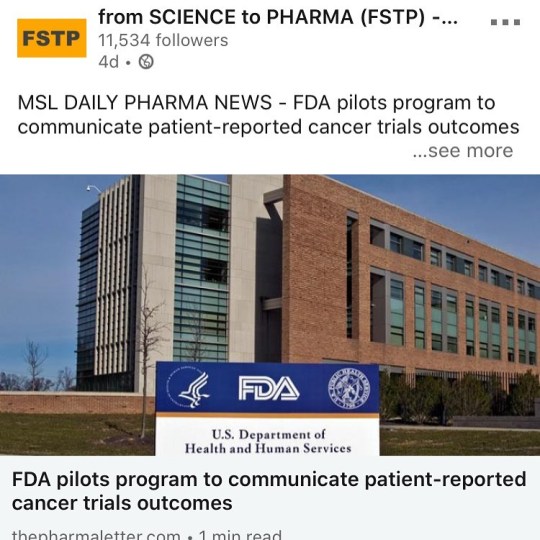#PatientReportedOutcomes
Explore tagged Tumblr posts
Photo

MSL DAILY PHARMA NEWS - FDA pilots program to communicate patient-reported cancer trials outcomes #PRO #PatientReportedOutcome “The US Food and Drug Administration yesterday launched Project Patient Voice, an initiative of the FDA’s Oncology Center of Excellence (OCE). Through a new website, Project Patient Voice creates a consistent source of publicly available information describing patient-reported symptoms from cancer trials for marketed treatments. While this patient-reported data has historically been analyzed by the FDA during the drug approval process, it is rarely included in product labeling and, therefore, is largely inaccessible to the public. “Project Patient Voice has been initiated by the Oncology Center of Excellence to give patients and health care professionals unique information on symptomatic side effects to better inform their treatment choices,” Free webinar on “how to become an MSL” https://lnkd.in/gFYBJ2G Or click on our profile. Click below to read further, like and share it and follow us to learn more. #MSL #FSTP #MSLcert #medicalscienceliaison #MedicalAffairs https://lnkd.in/exMKqZD https://www.instagram.com/p/CCAmDcZjimG/?igshid=d0v8czoc34j3
0 notes
Text
How Patient-Reported Outcomes are Rocketing Patient Organizations to the Next Level
by Taylor Cusher, Associate Director
At FasterCures, we see great potential in more effectively using patient-reported outcomes (PROs) to advance the science of patient input. Patient organizations could play an important role in supporting that effort.
In theory, many agree that PROs used in research and clinical care should be based on what patients report as being most important to their disease management, health, and well-being, but this has often not been adequately considered as part of routine practice. Ensuring that PROs themselves are truly patient-centered is one element of the challenge ahead. Another challenge is aligning various stakeholders’ interest in, and their use of, PROs.
There are many groups of stakeholders, each with their own goals for using PROs:
o Patients and caregivers hope that using patient-centered PROs will advance medical products that present better treatment options and/or can be used to inform care decision-making.
o Drug and device companies use PROs to demonstrate impacts of medical products that matter to patients and/or to differentiate their products from others in the same market.
o Clinicians frequently use PROs to assess how well individual patients feel or function as a basis for shared decision-making about care.
o Hospitals and clinics use PROs and other tools to understand clinical care outcomes or the way particular care approaches affect patient health and health-care utilization at the population level.
o The Food and Drug Administration (FDA) can use PROs, as long as they meet certain data requirements, as part of its benefit-risk determination and as evidence of unmet medical need.
o Payers use comparative and cost-effectiveness data, which can include PROs, to make reimbursement decisions.
At the end of 2017, FasterCures surveyed organizations that are using patient-centered PROs in their patient registries. The goal was to better understand the role patient organizations are playing in advancing the use of PROs.
Methods
We conducted the survey through the Patients Count Network, a digital directory of patient organizations maintained by FasterCures. Patients Count Network involves nearly 150 patient organizations of all sizes and areas of focus. The network serves as a one-stop shop to find patient organizations and as a mechanism for these organizations to showcase their programmatic and research resources.
We sent a survey on patient-centered measurement to 142 current members in late 2017. The goal was to better understand the types of work that they are doing related to PROs, who they are partnering with, and the purpose of their efforts. Thirty percent of organizations (42) responded. Most of the organizations are small, with 10 or fewer staff.

Conclusions
Three-fourths of patient organizations surveyed are working on PROs.


Patient organizations are using their resources in multiple ways to advance the development and use of PROs. They indicated many uses for PROs and patient-perspective data and are partnering with different organizations and stakeholders to accomplish their work. Patient organizations are positioned to work within and possibly across diseases and conditions and may be an underappreciated partner in the development and use of patient-centered measurement.



Based on our findings and our prior work in this area, we recommend three key actions to drive patient-centered PROs forward:
1. Collaborate: Find the patient organizations that represent your disease area(s) of interest. They may already be doing great work, but if not, work with them early and often to make their needs and perspectives a starting point.
2. Find success and build on it: Where have PROs been successfully aligned with patients and effective for decision-making in R&D or care delivery? Don’t recreate the wheel, but do make sure existing PROs are aligned with what patters to patients.
3. Consider technology: Electronic delivery of PROs and technology to manage and make use of the data are going to be critical aspects of the future viability and success of PROs.
For more of FasterCures’ work on patient-reported outcomes, check out the following resources:
· Webinar: Patient-Centered Measurement: How Close Are We?
· White paper: Patient-Reported Outcomes: Design with the End in Mind
· Blog post: Patient-Reported Outcomes and the Elephant in the Conference Room
· Blog post: What the Pros Know about PROs: Top 3 Lessons Learned from Implementing Patient-Reported Outcomes
1 note
·
View note